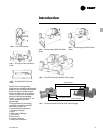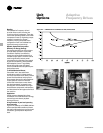
CTV-PRC007-EN12
CenTraVac
™
Three-Stage P-H Diagram
The pressure-enthalphy (P-H) diagram
describes refrigerant flow through the
major CVHE/CVHG chiller components.
This diagram confirms the superior
operating cycle efficiency of the three-
stage compressor and two-stage
economizer.
Evaporator — A liquid-gas refrigerant
mixture enters the evaporator at state
point 1. Liquid refrigerant is vaporized to
state point 2 as it absorbs heat from the
system cooling load. The vaporized
refrigerant then flows into the
compressor first stage.
Compressor First Stage — Refrigerant
gas is drawn from the evaporator into
the first stage compressor. The first stage
impeller accelerates the gas increasing
its temperature and pressure to state
point 3.
Compressor Second Stage —
Refrigerant gas leaving the first stage
compressor is mixed with cooler
refrigerant gas from the low pressure
side of the two-stage economizer. This
mixing lowers the enthalpy of the
mixture entering the second stage. The
second stage impeller accelerates the
gas, further increasing its temperature
and pressure to state point 4.
Compressor Third Stage — Refrigerant
gas leaving the compressor second
stage is mixed with cooler refrigerant
gas from the high pressure side of the
two-stage economizer. This mixing
lowers the enthalpy of the gas mixture
entering the third stage compressor. The
third stage impeller accelerates the gas,
further increasing its temperature and
pressure to state point 5, then discharges
it to the condenser.
Condenser — Refrigerant gas enters the
condenser where the system cooling
load and heat of compression are
rejected to the condenser water circuit.
This heat rejection cools and condenses
the refrigerant gas to a liquid at state
point 6.
Patented Two-Stage Economizer and
Refrigerant Orifice System-Liquid
refrigerant leaving the condenser at state
point 6 flows through the first orifice and
enters the high pressure side of the
economizer. The purpose of this orifice
and economizer is to preflash a small
amount of refrigerant at an intermediate
pressure called P1. P1 is between the
evaporator and condenser pressures.
Preflashing some liquid refrigerant cools
the remaining liquid to state point 7.
Refrigerant leaving the first stage
economizer flows through the second
orifice and enters the second stage
economizer. Some refrigerant is
preflashed at intermediate pressure P2.
Preflashing the liquid refrigerant cools
the remaining liquid to state point 8.
Another benefit of preflashing refrigerant
is to increase the total evaporator
refrigeration effect from RE’ to RE. The
two-stage economizer provides a seven
percent energy savings compared to
chillers with no economizer.
To complete the operating cycle, liquid
refrigerant leaving the economizer at
state point 8 flows through a third orifice
system. Here, refrigerant pressure and
temperature are reduced to evaporator
conditions at state point 1.
CenTraVac Two-Stage P-H Diagram
The pressure-enthalphy (P-H) diagram
describes refrigerant flow through the
major CVHF chiller components. This
diagram confirms the superior operating
cycle efficiency of the two- stage
compressor and economizer.
Evaporator — A liquid-gas refrigerant
mixture enters the evaporator at state
point 1. Liquid refrigerant is vaporized to
state point 2 as it absorbs heat from the
system cooling load. The vaporized
refrigerant then flows into the
compressor first stage.
Compressor First Stage — Refrigerant
gas is drawn from the evaporator into
the first stage compressor. The first stage
impeller accelerates the gas increasing
its temperature and pressure to state
point 3.
Compressor Second Stage —
Refrigerant gas leaving the first stage
compressor is mixed with cooler
refrigerant gas from the economizer.
This mixing lowers the enthalpy of the
mixture entering the second stage. The
second stage impeller accelerates the
gas, further increasing its temperature
and pressure to state point 4.
Condenser — Refrigerant gas enters the
condenser where the system cooling
load and heat of compression are
rejected to the condenser water circuit.
This heat rejection cools and condenses
the refrigerant gas to a liquid at state
point 6.
Economizer and Refrigerant Orifice
System-Liquid refrigerant leaving the
condenser at state point 6 flows through
the first orifice and enters the
economizer. The purpose of this orifice
and economizer is to preflash a small
amount of refrigerant at an intermediate
pressure called P1. P1 is between the
evaporator and condenser pressures.
Preflashing some liquid refrigerant cools
the remaining liquid to state point 8.
Another benefit of flashing refrigerant is
to increase the total evaporator
refrigeration effect from RE’ to RE. The
economizer provides a 4
1
/2 percent
energy savings compared to chillers with
no economizer. To complete the
operating cycle, liquid refrigerant leaving
the economizer at state point 8 flows
through a second orifice system. Here,
refrigerant pressure and temperature are
reduced to evaporator conditions at state
point 1.
Three-Stage CenTraVac P-H Diagram
Two-Stage CenTraVac P-H Diagram
Features and
Benefits
Refrigeration
Cycle (Cont.)


















